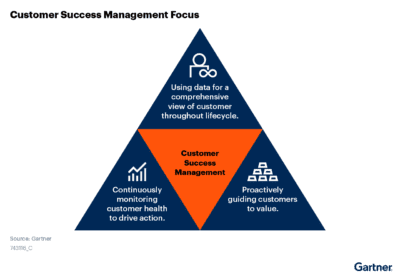As the technology market enters a new phase, SaaS leaders face a challenge: how to grow their businesses efficiently.
The answer? A well-oiled customer success (CS) machine that drives Net Revenue Retention (NRR).
SaaS organizations must align their teams around customer outcomes, and scale their CS team’s efforts with the utmost efficiency. To do this, CS leaders should operationalize CSM motions through a robust customer success management platform.
Why a Customer Success Management Platform?
CS platforms may have started out as a centralized repository for customer data, but they’ve become so much more than that. Today, they’re the lynchpin of an efficient, durable growth strategy for technology companies. The 2022 Gartner Market Guide for Customer Success Management Platforms reports that “customer success management (CSM) programs have progressed from an emerging discipline into an increasingly mature and evolving practice.”
In this report, Gartner breaks down the three pillars of customer success management platforms: “continuously monitoring customer health to drive action; using data for a comprehensive view of the customer throughout lifecycle; [and] proactively guiding customers to value.”

By examining these pillars and CS market trends, we’ve taken away three lessons in efficiency from the 2022 Gartner Market Guide for Customer Success Management Platforms.
1. Transform manual methodologies to scalable digital strategies
It’s clear that as customer success has evolved, it has outgrown manual tracking methods and high-touch approaches that require ever-increasing CSM headcount. According to Gartner,
“CSM requires increasingly large teams and cross-functional participation to help customers realize value. Point solutions or manual tracking methods become cumbersome and error-prone and do not enable uniform support for customer success across a growing customer base, multiple regions, and an expanding product portfolio.”
At Gainsight, we work with many organizations that started with a manual, high-touch approach to CS—and they’re currently struggling to scale. We believe that’s where digital customer success comes to the rescue. Digital-led strategies are helping CS teams do more with less, without forfeiting a human-first experience for the customer.
Gartner continues:
“To scale CSM practices across different customer segments and product types, the platform must be able to support tech-touch or low-touch models driven through data-driven automation.”
We couldn’t agree more. At Gainsight, we know top CS teams are charged with driving Net Revenue Retention, adoption, expansion, and more. That means tech-touch, automation, pooled CSM models, and other digital customer success strategies are becoming critical to fuel efficient growth.
We believe that scaling through digital-led strategies is so essential to efficiently driving NRR that we included it in our Durable Growth Playbook for Savvy SaaS Companies.
2. Use your product to drive adoption and expansion
One of the key findings in the Gartner report is that, “To provide more transparency and predictability in achieving customer renewal and growth targets, technology plays a central role for customer success to: continuously refine best practices for guiding a customer to obtain value from the product.” At Gainsight, we believe that combining both customer data and product data towards this pursuit is a recipe for success.
Gartner continues:
“Companies pursuing a PLG strategy need to leverage product usage data, in-app guidance, and marketing automation to prompt customers to adopt—and ultimately buy.”
In our opinion, leading CSM platforms are poised to work hand-in-hand with product-led growth (PLG) strategies. We feel CS and Product teams are invaluable resources to one another. Joining forces arms Product teams with insights into how the customer drives value from the product—or doesn’t—which in turn informs the product roadmap.
CS can leverage product usage data and in-app messaging channels to guide customers to value. For instance, Customer Success Managers can advise customers to adopt the features that will deliver the right outcomes throughout their journey.
Ultimately, CS and Product teams need to utilize all of the data at their disposal to drive efficient growth, while keeping the customer at the center of their work. In our Durable Growth Playbook for Savvy SaaS Companies, we highlight how game-changing it is to maintain a customer-centric product roadmap.
3. Communicate and collaborate with your customers
Finally, communication is key—are you making the most of your customer conversations?
Customer success platforms offer a wide range of functions to not only communicate with your user base, but also collaborate and partner with them to achieve their goals.
Gartner says,
“While CSM platforms started as a collection point for customer data and engagement to be shared internally, we see some providers beginning to extend their capabilities to enable external communication and collaboration with customers. Although this capability is still emerging among vendors, it has the potential to reduce effort for both the customer and the CSM teams. This may take the form of summarizing data into shareable slides for external audiences, quarterly business reviews (QBRs), or even direct customer project collaboration portals.”
At Gainsight, we call this keeping the customer in customer success—and it’s a smart play for SaaS organizations pursuing efficient, durable growth. It may seem obvious, but the work of CS must revolve around the customer experience and customer outcomes first and foremost. By harnessing the full power of a CS platform, CSMs can not only stay up to date with customer health metrics but also use that data to provide stakeholders actionable guidance right in their own dashboards.
To learn more about CS solutions and industry trends, read the full Gartner report: “Market Guide for Customer Success Management Platforms.”
Gartner Disclaimer:
Gartner, Market Guide for Customer Success Management Platforms, By Michael Maziarka, Maria Marino, Robert Blaisdell, 27 June 2022.
Gartner is a registered trademark of Gartner, Inc. and/or its affiliates in the U.S. and internationally and is used herein with permission. All rights reserved.
Gartner does not endorse any vendor, product, or service depicted in our research publications, and does not advise technology users to select only those vendors with the highest ratings or other designation. Gartner research publications consist of the opinions of the Gartner research organization and should not be construed as statements of fact. Gartner disclaims all warranties, expressed or implied, with respect to this research, including any warranties of merchantability or fitness for a particular purpose.

